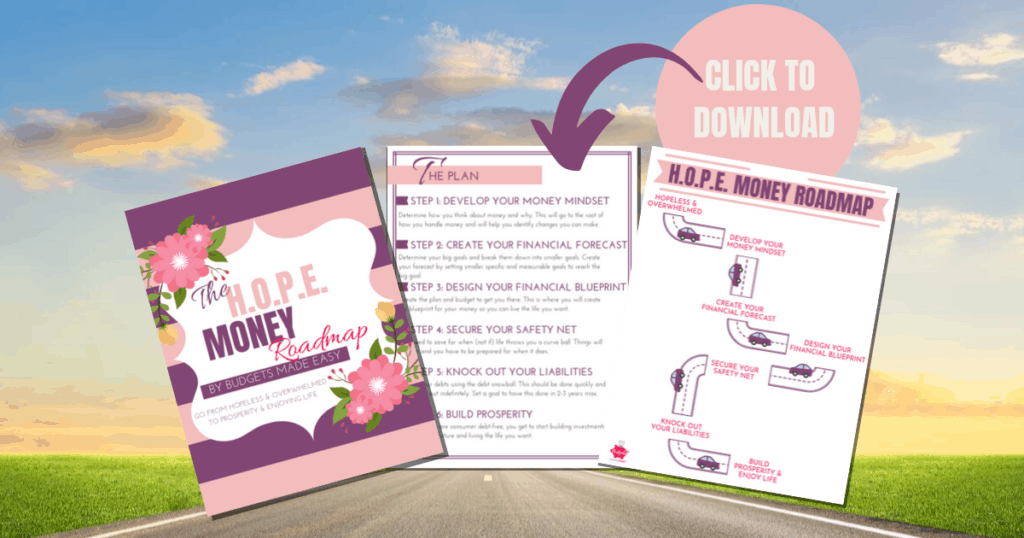
Learning to manage your money in such a way that you can stress less and live the life you want can seem like a pipe dream you will never achieve.
With 80% of Americans living paycheck to paycheck, it can seem impossible to get out of debt and save money.
However, doing just that is possible with a plan and the motivation and determination to get there.
My goal for you is to become consumer debt-free and eventually 100% debt-free.
That means ALL your credit cards, car loans, HELOC, 401(k) loans, student loans, I mean EVERYTHING.
When you have a blueprint of how to do it, it can take the overwhelm and stress out of finally doing it.
I know when I am not sure which step to take, I freeze with indecision and just do nothing.
H.O.P.E. Money Roadmap
This is why I have created the H.O.P.E. Money Roadmap.
It will take you from Hopeless and Overwhelmed to Prosperity and Enjoying life!
This plan is a simple to follow and understand financial blueprint that will get you from stuck to moving.
You may even be surprised that the first two steps aren’t even about the numbers!
DOWNLOAD YOUR H.O.P.E. MONEY ROADMAP QUICK START GUIDE:

How The H.O.P.E. Money Roadmap Can Help You
In this article you will learn:
- How to change your mindset around money
- How to create a new plan for your money
- Design your own financial blueprint
- Secure your safety net
- Pay off your debts quickly
- Build prosperity
While working through these steps, it’s important to take it ONE step at a time. Don’t try to skip ahead or do multiple together.
Doing it one step at a time, reduces the overwhelm and stress around getting started.
While working through this plan, I want you to remember why you started.
My ultimate goal for you is for you to be able to live the life you want, however that looks for you. For me, it was being able to leave a stressful job that I was burned out on to stay at home with kids and build my business,
I want you to write down what a life you want looks like and keep it somewhere you can be reminded of it daily.
Now that may seem like a lot to take in right now, so grab your printable PDF guide to keep as you track your progress. If you are truly ready to make the changes you need to makeover your finances, this is your guide to do it.
The H.O.P.E. Money Roadmap
The H.O.P.E. Money Roadmap will take you from Hopeless and Overwhelmed to Prosperity and Enjoying Life. This money roadmap consists of 6 steps to help you create your roadmap to get you there. Each step has its own goals and focus for you which is why you need to do it one at a time.
Your ultimate goal is to pay off your debt and live the life you want while building wealth and saving for your future.
In order to do that, we have to take one step at a time and not lose focus by getting overwhelmed by the bigger picture.

Step 1: Develop a Money Mindset
You may want to jump to the next step, but this is the most important step, which is why it is #1.
This is also why I have created The Money Mindset Podcast!
Identifying how you think about money and your limiting beliefs will set you up for success in the long run.
It order to identify what your thoughts and dreams are, you should take 10-15 minutes and just sit and write them out.
If you are married, do this separately then come together and talk about it so you can understand each other and get on the same page.
Things to Think About When Working Through Your Mindset
When you are working through your mindset, I want you to think about some specific things.
- Identify how your parents handled money and how that makes you feel now
- Identify how you feel about money, do you think it’s good or bad, infinite or finite
- Do you belive you can be debt-free why or why not
- What do you want to do that you can’t now because of money
- Dream big! Write out your big dreams for your life irregardless of money

This exercise will help you identify where you are with your money mindset so you can start to change it.
How Does Money Make You Feel?
Some things I want you to think about while writing this out is how money makes you feel and what is the root cause for you feeling that way.
Do you believe that if someone else has more then that means you will have less?
Do you hoard money because you are afraid of being poor like your parents?
Do you overspend because you are really depressed and shopping gives you a few minutes of happiness?
I want you to work through this exercise and really think about money and why. Then I want you to think about if it is a feeling based on reality.
A lot of times we think things that aren’t really true because of our own perceptions and experiences. However, statistically the information we believe may not be an accurate representation of reality.
For instance, do you belive that most millionaires inherited money?
That belief that many people believe is true, is not true.
Most millionaires in America today did not inherit money. They are self-made millionaires.
I also like to point out that people sometimes have a belief that millionaires make a million dollars a year and live like the Kardashians.
That is not accurate or based in reality either.
A millionaire is someone that has a net worth over a million dollars.
They can make $55,000 a year and be a millionaire.
The book, The Millionaire Next Door does a very good job of explaining how a millionaire acts, spends, and invests. It will surprise you.
They aren’t out on their yachts every weekend.
They spend $25 on jeans, don’t buy new cars, and invest their money wisely.
So, I want you to know and believe in your heart that this can and WILL be you one day.
This plan will help you create the plan to get there and succeed.
Step 2: Create Your Financial Forecast
Once you identify your dreams and goals and work on your mindset, it’s time to create your financial forecast.
In this step we are going to make our goals a reality and make the plan for that to happen.
If we just keep “wishing” for it to happen some day, it will never happen.
You have to create a plan and then execute if you want things to change.
I love goal planning using the S.M.A.R.T. method.
This method is great because it helps you break your goals down into actionable and attainable steps.

The S stands for being Specific.
When making a goal, it’s not specific enough to say you want to lose weight or save money.
You need to know how much, when, why, and what things may prevent you from reaching the goal.
You need to know where you are and where you need to go so you can make the actual plan to get there.
How much debt do you need to pay off?
How much money do you need to save?
How quickly do you want to it?
The answers to these questions are the building blocks for getting to a place that you can live the life you want.
The M stands for Measurable.
Once you have your specific goal, it needs to be measurable.
So, it can’t be I want to pay off debt. That isn’t measurable or specific enough.
A better way to say it is: I want to pay off $45,000 in two years.
That is specific and measurable.
The A stands for Attainable.
This means you need to know if you can actually reach the goal.
Do you have the skills, knowledge, money, and talent to be able to achieve this goal.
Lucky for you, when it comes to managing your money better, you can build those skills and you can make more money.
The R stands for Relevant.
Do you actually want to achieve this goal. What is the objective and why do you want to reach this goal.
Does it really fit your bigger life plan.

The T stands for Timely.
This step is about breaking your goals down into smaller chunks of time.
You don’t want it to take years to achieve your goals.
If you want to be debt free, that most likely can be done in 2-3 years. If it takes you 5-10 years, you won’t do it.
Breaking Your Financial Goals Into Smaller Goals
So for this step I want you to break your financial goals down into smaller goals to reach your big goals.
Set a goal this week to work through steps 1-2.
Then another week to work through step 3.
Step 4 should take 1-2 months.
Step 5 should not take more than 3 years at the absolute most.
So set a goal for this week, this month, 6 months, 1 years, 18 months, 2 years, and 3 years.
When you use the S.M.A.R.T. method to plan out your financial forecast, you will be more likely to follow through and keep yourself accountable to reaching the bigger goal.

If your forecast is simply to pay off debt in 5 years, in 5 years you will not have paid off your debt.
However, if your forecast looks like this, you are more likely to achieve it:
Week One Goal: Work on developing my money mindset
Week Two Goal: Work on creating my financial forecast
Month One Goal: Designing my financial blueprint
Month Two Goal: Secure my safety net
Month Six Goal: Have $5000 paid off
Month Twelve Goal: Have $15,000 paid off
Month Eighteen Goal: Have $30,000 paid off
Two Year Goal: Have $35,000 paid off
And so on…
You can also list the debts you want paid off with the dollar amounts so it’s even more specific.
The goal is for you to write out and visualize your goals and break them down into specific, measurable and timely increments.
DOWNLOAD YOUR H.O.P.E. MONEY ROADMAP QUICK START GUIDE:

Step 3: Design your Financial Blueprint
This step is where you lay out the plan for achieving your goals.
This is where you will do your budget which is the foundation for everything else you will do with your money.
Your blueprint will help you know what to spend and not spend money on.
It will help you stay focused when times get tough but it’s also your permission to have some fun.
You budget shouldn’t be all work and no play.
If you have some extra money, you should have some fun with it too.
Now this doesn’t mean to go on a crazy shopping spree or to continue spending like there’s no tomorrow.
It does mean that you can budget in some money to have some fun. As long as it’s planned and in the budget, then you don’t have to feel guilty about it.
You also don’t have to worry about the credit card bill coming next month. You can pay for it with cash and just ENJOY yourself!

Step 4: Secure Your Safety Net
This step is all about building your buffer in case of an emergency.
This step comes before paying off debt because it will help you avoid adding more debt to your pile.
It’s hard to pay off debt if you are still adding to it.
This is your safety net WHEN an emergency pops up because it will.
Then when it does, it mostly likely will just be an inconvenience instead of an emergency since you have the money saved.
During this step you are only focused on saving money, not saving money AND paying off debt.
The amount you save should be at least $1000. In many circumstances you should save more, but $1000 gives you a quick win.
Plus if you have never saved in your life, then $1000 seems like a mountain but it is possible. It will help you feel motivated to keep going when you can reach that $1000 milestone.

There are situations that you may need to save more than $1000 but you should still be proud and celebrate saving $1000.
If you are planning a move, expecting a job loss, have medical issues, or even if you have a job that is dependant on the weather, save more than that before moving on to step 6.
Set a goal for the amount you want to save and then break it down so you can still get the win and then celebrate your success.
It is easier to move through the steps when you focus on ONE thing at a time. Put all your time, energy, and money toward one thing and you will accomplish it soooo much faster and easier than trying to do too many things at once.
Step 5: Knock Out Your Liabilities
This step is where you focus on just paying off your consumer debt.
This step does not include your primary mortgage.
It does include everything else including:
- 2nd mortgage
- HELOC
- 401(k) loans
- Car loans
- Credit cards
- Personal loans
- Family loans
- Medical bills
- EVERYTHING
During this step you are only focusing on debt.
To start, you will list out all your debts from smallest to largest balance. The interest rate does not matter for this.
Once you have your list, you will focus on ONE at a time. All your extra money will go toward the smallest debt while paying the minimum payments on everything else.
It truly doesn’t matter if you use the debt snowball or debt avalanche or whatever method you want as long as you do it and do it fast.
The debt snowball works because it helps keep you motivated long-term. If you try to start paying off your highest interest rate first and it’s $80,000 that could take you a long time to see any results.
However, if you start with small medical bills and pay them off this month, well you got a quick win and can see that you can do it.
Start small and build up momentum to the big stuff so you can knock it down easier!
Step 6: Build Prosperity
Now that you have some money saved and have your consumer debt paid off, it’s time to build prosperity and your legacy.

This is your opportunity to build wealth and really change your family tree. You can give to those in need, save for retirement, pay off your house early and even help your kids with college.
This is the step where you can pay off your house early, beef up your retirement and savings accounts.
You can even start saving for your kids college funds!
Prosperity to me is more than just building wealth, it’s also about giving generously, building up others, and building a life you want.
It gives you the ability and the freedom to be able to choose what you want to do. Whether it’s changing jobs, starting a new business, or traveling the world.
The destination is up to you, but it’s the blueprint that gets you there.
Emergency Fund
Start step 6 by building up your emergency fund. This will help you avoid going into debt again. This is your buffer against what life will throw at you.

You emergency fund should be 3-6 months of expenses but depending on your situation, you may need to do more than that.
Once you have that saved, then you start building up your retirement savings.
This step can get overwhelming if you think about all the things you want to do. Remember, focus on one thing at a time.
If you want to build up investments, focus on that. If you want to focus on paying off your mortgage, invest 15% of your income and then everything extra goes toward your mortgage.
Keep in mind that once you get to this step, you want to stay here but you don’t have to be as intense about things.
You want to be able to enjoy your life and not worry about every single penny. You still have to be intentional with your money but allow yourself to have more fun.
What’s the point of getting here if you are miserable?
I would even recommend revisiting steps 1 & 2 and make new bigger goals to work on.
That way you know what to focus on once you get here.
Summary:
These simple steps will help you reach your financial goals easier and faster than ever before.
It will help you build a foundation that will be rock solid that will lift you when times are hard.
When you know where you are and where you want to go, you just need the road map.
Once you create the map, you just have to start moving in the right direction.
As long as you are headed in the right direction, it doesn’t matter how fast or slowly you get there, you will get there.
DOWNLOAD YOUR H.O.P.E. MONEY ROADMAP QUICK START GUIDE:

Problems downloading Road map,404
You will still get the roadmap in your email inbox. My service provider messed up the thank you page link. I think it’s fixed now:)
Thank you!